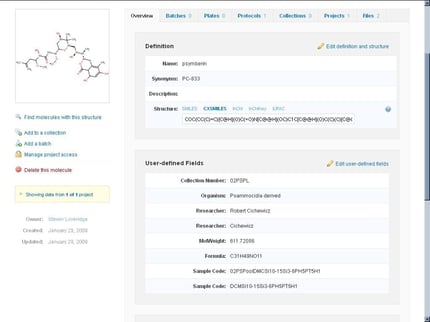42 Years in the Sea
Guest blog courtesy of Karen Tenney at UCSC
In June 2012, Phil Crews, Distinguished Professor of Chemistry at the University of California, Santa Cruz, delivered his last official “Introduction to Organic Chemistry” lecture after 42 years of teaching. Literally thousands of students have benefited from his dedication to education! This retirement from academia is only partial as he plans to continue his research in chemistry of marine natural products that began in 1974 after perusing a book entitled Poisonous and Venomous Marine Animals of the World. From this book he learned that extracts from sponges exhibit antibiotic and anti-parasitic properties but their chemistry is largely unknown. His imagination captivated, he decided to embark on the adventurous research path at UCSC that continues to be highly productive nearly forty years later.
Oceanic field work is an essential component of any marine natural products research program. The Crews lab has collectively conducted more than 85 field expeditions to study sites around the world including Papua New Guinea, Vanuatu, Fiji, Tonga, Solomon Islands, American Samoa, Indonesia, Malaysia, the Red Sea, Venezuela, U.S. Virgin Islands, Puerto Rico, Hawaii, Cayman Islands, Gulf of Mexico, and the Monterey Bay. Field strategies for the collection of marine sponges and deep-water sediments are an evolving and integral aspect of this work which has significantly deepened the understanding of chemical ecology and secondary metabolite biosynthesis.
To date, more than a thousand unique compounds from marine sponges and marine-derived fungi have been discovered in the Crews Marine Natural Product research group. The guidelines and techniques for the isolation and characterization of novel pure compounds from the marine environment introduced by Dr. Crews are published in his popular textbook “Organic Structure Analysis.”
Many of the compounds were isolated using bioactivity-guided fractionation, working in collaboration with on- and off-campus partners, including Novartis Institutes for Biomedical Research, the Ford Cancer Center, Gilead Biosciences, Eisai Research Institute, and with the McKerrow Group at the UCSF Center for Discovery and Innovation in Parasitic Diseases (read more in the CDD Spotlight interview with Prof. Jim McKerrow here). The National Cooperative Drug Discovery Group (1990-2011) focused on targeted discovery of anticancer therapeutics from marine sources.

Screenshots used with permission per CDD privacy and security policy
Notably, two marine sponge-derived compound classes discovered in the Crews lab, the bengamides and the psammaplins, provided the basis for synthetic derivatives
(NVP-LAF389, LAQ-824, and LBH-589) for evaluation in anticancer clinical trials. Another productive and ongoing collaboration forged in 1989 by Professor Crews with Dr. Fred Valeriote of the Ford Cancer Center in Detroit, Michigan, employs a soft agar colony-based disk diffusion assay using a panel of murine and human cancer and normal cell lines. Some of the major solid tumor-selective compound discoveries include the milnamides, fijianolide, mycothiazole, and psymberin.
It was during the early days of a QB3-funded collaboration with Professor James McKerrow’s group at UCSF that the Crews group learned about CDD. At the time, the lab was using an Access database that was nearly maxed out with data points. In need of a user-friendly way to archive and mine bioassay data for the thousands of crude extracts, fractions, and compounds from marine sponges and marine-derived fungi, Phil Crews realized that CDD was the solution. It allowed to track samples screened in multiple bioassays as well as to mine the CDD public pure compound repository for new collaborations and potential therapeutics.
Currently, there are several exciting new research and collaborative developments in the Crews lab. A collaboration with Gilead Biosciences, which includes the Linington lab at UCSC and the Chemical Screening Center formed by Professor Scott Lokey, focuses on the discovery of new antiviral compounds. Another collaboration with Dr. James LaClair at UCSD-SIO is working on development of a deployable artificial sponge device , And then there is the recent isolation of bengamide analogues from a terrestrial myxobacteria, and a USAID-funded partnership (Asst. Prof. Roger Linington, PI, and Prof. Phil Crews, Co-PI) to build a marine biotechnology collaboration between UC Santa Cruz and three institutions in Indonesia, the Eijkman Institute for Molecular Biology in Jakarta, Hasanuddin University in Makassar, and Diponegoro University in Semarang. In recent years, the lab’s research horizon has also grown beyond sponge chemistry to include marine and terrestrial myxobacteria, a unique group of gram-negative microorganisms with interesting secondary metabolite chemistry.
References
- Johnson, TA; Sohn, J; Inman, WD; Estee, SA; Loveridge, ST; Vervoort, HC; Tenney, K; Liu, J; Ang, KK-H; Ratnam, J; Bray, WM; Gassner, NC; Shen YY; Lokey, RS; McKerrow, JH; Boundy-Mills,K; Nukanto, A; Kanti, A; Julistiono, H; Kardono, LBS; Bjeldanes, LF; Crews, P. Natural Product Libraries to Accelerate the High-Throughput Discovery of Therapeutic Leads. Journal of Natural Products 2011, 74(12), 2545-2555.
- Radjasa, OK; Vaske, YM; Navarro, G; Vervoort, HC; Tenney, K; Linington, RG; Crews, P. Highlights of marine invertebrate-derived biosynthetic products: their biomedical potential and possible production by microbial associants. Bioorganic & Medicinal Chemistry 2011, 19(22), 6658-6674.
- Watts, KR; Tenney, K; Crews, P. The structural diversity and promise of antiparasitic marine invertebrate-derived small molecules. Current Opinion in Biotechnology 2010, 21(6), 808-818.
- Sashidhara, KV; White, KN; Crews, P. A Selective Account of Effective Paradigms and Significant Outcomes in the Discovery of Inspirational Marine Natural Products. Journal of Natural Products 2009, 72(3), 588-603.
This blog is authored by members of the CDD Vault community. CDD Vault is a hosted drug discovery informatics platform that securely manages both private and external biological and chemical data. It provides core functionality including chemical registration, structure activity relationship, chemical inventory, and electronic lab notebook capabilities!
CDD Vault: Drug Discovery Informatics your whole project team will embrace!


